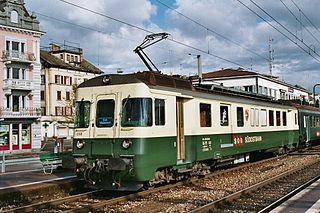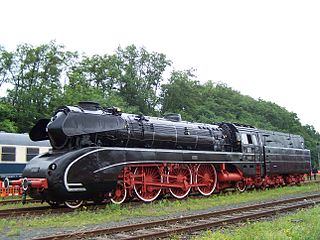
The Class 724 operated by the German national railway, Deutsche Bundesbahn, was a railway department vehicle used for testing Indusi installations. Only three examples of this class existed.

The Class 724 operated by the German national railway, Deutsche Bundesbahn, was a railway department vehicle used for testing Indusi installations. Only three examples of this class existed.
After its retirement on 21 June 1963, having clocked up 1,236,000 kilometres, the Uerdingen railbus VT 95 906, one of the original prototypes of its class, was converted in the repair shop ( Ausbesserungswerk or Aw) at Kassel into a test vehicle for Indusi railway installations. Designated as 6205 Wt it began its new duties on 25 February 1964 at Bahnbetriebswerk (Bw) Wuppertal and replaced the measurement draisine previously used for this task. On 1 January 1968 it was given the number 724 001–3. The installation of testing magnets on both sides of the vehicle in 1971 considerably improved its utility, making it possible to test station entry and exit signals in one pass. Number 724 001 was retired on 18 January 1986 at Bw Heidelberg. Since then the vehicle was left by itself for many years and eventually stood in a very dilapidated state in front of Worms locomotive shed. In 2007 the railbus was bought up by the Vulkaneifelbahn and taken away to Gerolstein, where the intention is to restore it in the medium-term.
No. 724 001 is the last existing Uerdingen railbus prototype, the former Class VT 95.
Because more and more lines were equipped with Indusi, one vehicle no longer proved sufficient. So in 1972 the retired railbuses, VT 795 144 and 471, were also converted to test vehicles, again at Aw Kassel, and numbered as 724 002-1 and 724 003–9.

A railbus is a lightweight passenger railcar that shares many aspects of its construction with a bus, typically having a bus body and four wheels on a fixed base, instead of on bogies. Originally designed and developed during the 1930s, railbuses have evolved into larger dimensions, with characteristics similar in appearance to a light railcar, with the terms railcar and railbus often used interchangeably. Railbuses designed for use specifically on little-used railway lines were commonly employed in countries such as Germany, Italy, France, the United Kingdom and Sweden.

British Rail produced a variety of railbuses, both as a means of acquiring new rolling stock cheaply, and to provide economical services on lightly-used lines.

The British Rail Class 210 was a type of diesel-electric multiple unit (DEMU) passenger train designed and constructed by British Rail Engineering Limited's Derby Litchurch Lane Works.

The Eisenbahnmuseum Bochum-Dahlhausen is a railway museum situated south of the city of Bochum in the state of North Rhine-Westphalia, Germany. It was founded by DGEG, the German Railway History Company in 1977 and is based in a locomotive depot that was built between 1916 and 1918 and ceased operation in 1969. Then DGEG took over the whole area of 46,000 square metres and built up the biggest railway museum in Germany. In the middle of the museum, there is an engine shed with fourteen tracks. A preserved turntable, coaling, watering, and sanding facilities are still in operation. This museum is integrated into The Industrial Heritage Trail a route of monuments from the history of the industry.

A motor coach or motorcar is a self-propelled passenger vehicle also capable of hauling a train. With multiple unit train control, one operator can control several "motor coaches", possibly even combined with locomotives, efficiently in the same train, making longer trains possible.

The Bavarian Class Gt 2×4/4 engine of the Royal Bavarian State Railways, was a heavy goods train tank locomotive of the Mallet type. It was later designated the DRG Class 96 by the DRG, DB and DR.

The German Class 03.10 engines were standard steam locomotives (Einheitsdampflokomotiven) belonging to the Deutsche Reichsbahn and designed for hauling express trains.
The steam railbuses of Bavarian Class MCCi were built between 1906 - 1908 for the Royal Bavarian State Railways for suburban services in the Munich area. Seven units were produced, the coach bodies being manufactured by MAN and the engines by Maffei.

The Uerdingen railbus is the common term for the multiple units which were developed by the German firm of Waggonfabrik Uerdingen for the Deutsche Bundesbahn and private railways after the Second World War. These vehicles were diesel-powered, twin-axle railbuses of light construction. The diesel motors were built into the chassis underneath the vehicle. The VT 95 and VT 98 of the former Deutsche Bundesbahn in particular, are associated with this concept. These vehicles were employed in passenger train duties on branch lines where steam or diesel train operations were less profitable. Including the units built under licence, a total of 1,492 power cars were built from 1950 to 1971; and the total number of units, including trailer and driving cars, was 3,306.

The steam locomotives of DB Class 10 were express locomotives with the Deutsche Bundesbahn in Germany after the Second World War. They were nicknamed 'Black Swans' as a result of their elegant shape.

The 'Hanover version' of the Wismar railbus was developed in the early 1930s as a light railbus for economical passenger services on branch lines in Germany.

The Eisenbahnfreunde Zollernbahn (EFZ) (Zollernbahn Railway Society) is a German railway society dedicated to the preservation of historic railway vehicles, especially steam locomotives, where possible in working order. The society arranges day and shuttle trips, predominantly in Baden-Württemberg in southwestern Germany. It is based at Rottweil.

The German express locomotive, number 18 201 of the Deutsche Reichsbahn in East Germany, appeared in 1960–61 at Meiningen Steam Locomotive Works as a conversion of the Henschel-Wegmann train locomotive 61 002, the tender from 44 468 and parts of H 45 024 and Class 41. It is the fastest operational steam locomotive in the world.

These DB Class V 100 diesel locomotives were produced in the late 1950s by the Deutsche Bundesbahn for non-electrified branch lines as a replacement for steam locomotives. The V 100 class was built in three different variants.
The Stadler Regio-Shuttle RS1 is the first widely used, new-generation, diesel railcar in Germany and Czech Republic for local railway services. Its most characteristic feature is the trapezium-shaped window frames. The Regio-Shuttle is classified by the Deutsche Bahn as Class 650, by the České Dráhy as Class 840 or Class 841, however numerous private railways have their own Regio-Shuttles.

The Bahnbetriebswerk Passau is the locomotive shed that belongs to Passau's main station, the Hauptbahnhof.

The RegioSprinter is a German diesel railcar built by Siemens-Duewag for rapid regional railway services. Originally the RegioSprinter was designated as a Regional Combustion-engined Railbus by Duewag.

The DB Class 614s are German diesel multiple units operated by the Deutsche Bundesbahn, comprising two Class 614 driving units and up to two Class 914 centre cars. On 1 January 1994 the ownership of these vehicles was transferred to the DB's legal successor Deutsche Bahn and its subsidiaries or business areas.

ŽS series 812 was a diesel motor railbus operated by Serbian Railways. Originally it was the German Uerdingen railbus produced by Goša FOM for Yugoslav Railways (JŽ).

The Elmshorn–Bad Oldesloe railway is a regional railway line that has existed since 1896 in the south of the German state of Schleswig-Holstein. It has been operated since 1981 by the AKN Eisenbahn.